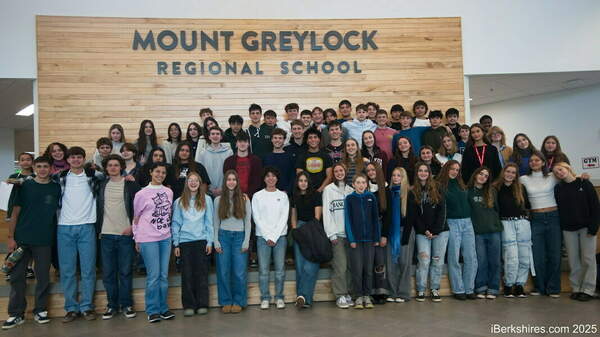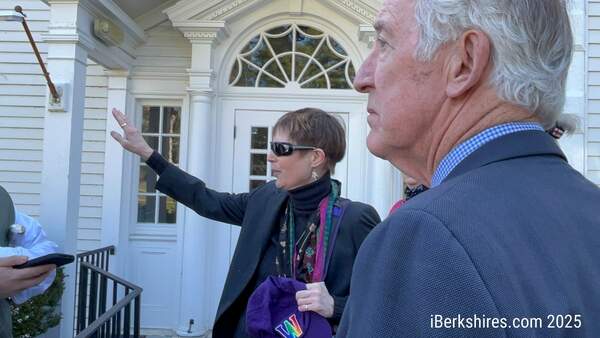Williamstown Methodists Reflect on Church's History
 After 131 years, the Methodist church in Williamstown will be put on the market as the congregation merges with the North Adams Methodists in the new year. |
By a required two-thirds affirmative vote on Oct. 10, the First United Methodist churches of Williamstown and North Adams passed a motion to merge their congregations and assets as of Jan. 1, 2011.
The Williamstown church voted in favor of putting their building at 777 Main St. on the market to be sold, but certain congregants disapprove of that decision.
"I'm too upset to talk about what's happening," said a member who requested anonymity.
Over the years, the Williamstown church has been the location for a variety of social events and fundraisers, such as the annual tag sale that took place on the lawn. The tag sale's friendly atmosphere was very different from what the first Methodists who settled in Williamstown in the early 1800s encountered. They suffered persecution, with people interrupting services and jeering the circuit preachers as they walked the streets. The Methodists also were the target of students' misbehavior.
The book “Williamstown: The First 250 Years 1753-2003" describes an incident involving young men who attended Williams. One night in 1830, a group of "unscrupulous students" marched into a home “where the brethren and sisters gathered for prayer” and proceeded to disturb and insult the worshippers. Next, they went outside and seized a tub of pickles and hurled it through the window.
But the Methodists persisted, worshipping in members' homes, a school and above Sherman's Store, according to information in the historical booklet "Methodism in Williamstown 1821-1996."
The first Methodist church in Williamstown was a white frame building erected in 1845 at a cost of $2,400. The lot for the building, which in later years was fitted with a stage and became known as the Opera House, was acquired through the efforts and generosity of Summer Southworth, a manufacturer of cotton goods.
.
When the congregation grew in number to a point where a larger space was needed for services, Southworth contributed $8,000 toward building the present red brick church, which cost $13,000, aside from the lot and furnishing. The church was dedicated on March 6, 1872.
Southworth also gave the Methodists a gift of music, an Opus 447 pipe organ manufactured by the William A. Johnson and Son Co. of Westfield – renowned for the quality of organs they produced.
Now recognized as an historic instrument by the Organ Historical Society, Opus 447 is truly a gem of an instrument.
In "Methodism in Williamstown," Hanne Booth, a member of the Methodist church in Williamstown since 1964 and choir director for many years, shares her recollection of a day "disaster struck."
A racoon sneaked into the church and had a "panic attack" in the track mechanism of the organ. Splintering the delicate wood strips and chewing on the leather, the racoon rendered the organ unplayable. "We were to host an ecumenical Good Service the next day," Booth wrote.
Andover Organ Co. made an emergency visit and technician James Stewart, assisted by David Bowman, church trustee, worked more than 15 hours straight to repair the organ. Stewart left a note which read in part: "I HAVE EARNESTLY SPOKEN TO THE LORD ABOUT THIS MATTER AND ASKED HIM TO PLEASE KEEP ALL WILD CREATURES OUT OF YOUR BUILDING, AND ESPECIALLY OUT OF THE ORGAN. I know you will want to help HIM in this project."
 The North Adams church is also up for sale. |
"I am especially concerned about the stained-glass windows," she said. "I would like to locate the families and find out what they wish done with them."
One of those windows was dedicated in 1910 to Mrs. A. E. Hall. "We didn't know what her first name was," said Northup, "but with the help of the Williamstown House of Local History and Williams College we found out it was Carolyn."
As it turned out, Mrs. Hall's son graduated from Williams College and his obituary mentioned his mother's first name.
Northup joined the church when she was 23. "It was a year after I married Bill and moved to Williamstown," said the North Adams native, referring to her late husband. "Our children, Susan and Bill, were baptized and grew up (in the church). ... We've had wonderful pastors. They took a stand when it wasn't popular, but it made us strong."
The church's building committee exceeded its goal of $30,000 toward the addition of an educational facility. "The cornerstone was laid in 1961," Northup recalled. Later that year, the $86,000 building was dedicated, "and we filled it up with children." The church shares the building with the Williamstown Day Care Center.
Northup, who always has advocated for children, recalled that in 1970, high school students needed a place to gather. The church youth group undertook the project of transforming the second floor of the church into a youth center, which included painting it with psychedelic colors and hanging strobe lights. The youth center was open to all area teenagers. "Police commended us for keeping the kids off the streets," said Northup.
The program was expanded to include counseling for troubled teenagers, and one girl said she was actually saved from suicide. "(Pastor) Joe Cook was wonderful with children," said Northup.
Through the years, a variety of social events and fundraisers has been held at the church, some of which may seem strange today. "Toe" socials, first held in 1895, began with young ladies standing behind a curtain with their toes protruding under it and a number attached to their feet. When the young men arrived, they were given corresponding numbers. Thus a match was made for the evening. Proceeds from the first social were used to pay the church's gas bill.
At the Ladies Aid Society's first "Mum social," also held in 1895, attendees were supposed to refrain from speaking or laughing for a specified half hour of the event. If they failed to keep "mum" during that time, they were obliged to pay a fine of five cents. Admission was 10 cents, and ice cream was free.
Among other fundraisers the Methodists ran over the years were chicken and biscuit dinners, ice cream socials, auctions and Calico Fairs. The Women's Society of Christian Service hand-made quilts for the Calico Fair. A "Pennsylvania Bride's Quilt " was sold for $650 to Gayle Lewis. "That was exciting because Gayle kept bidding by telephone from Minnesota to our silent auction table," Alice Auge, a member since 1955, wrote in her contribution to the booklet "Methodism in Williamstown."
Since the time is drawing near for the congregations of the two churches to worship together on a regular basis, 32-year-old Brad Berriege, head of the transition committee, is a busy man.
The transition committee, composed of members of the Methodist church in Williamstown and North Adams, oversees nine subcommittees focused on individual aspects of merging, including relocating both congregations to a temporary location and searching for a site for a new church. The North Adams church closed last year and was put on the market this past spring. Congregants have been worshiping across the street at First Congregational Church.
"We are working out what our mission as a merged congregation will be. That will help in deciding what type building we need," said Berriege. The congregation will also decide on a new name by next July.
Micheline and Marc Toureille, members of First United Methodist Church of Williamstown for 60 years, feel that in these "terrible times" when churches are struggling financially, merging the Methodist churches in Williamstown and North Adams should prove beneficial. "For one thing, we will cut down on the cost of maintaining a church," Micheline Toureille said.
Natives of France, the Toureilles knew each other for 10 years before Marc emigrated to the United States. When Micheline followed in a year, they married and settled in Williamstown. (Marc Toureille's father was the Rev. Pierre Toureille, who rescued Holocaust victims during the war and, beginning in 1948, preached and taught in the United States.)
"We were only 19 and 20. The church adopted us – became our loving family," Micheline said. "It will be painful leaving the building because there are so many memories. But we [the congregation] still will be together, and wherever we go God goes with us."















